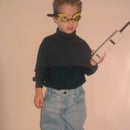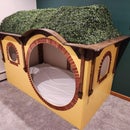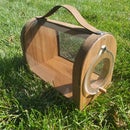Introduction: Bringing Old CO2 Pistol Back to Life
Not too long ago I was looking around in my grandfather's garage when I stumbled upon this beauty. He didn't want it any more so it was now mine but before I could plink away I would first need to make sure it was back in working order.
Upon research this model I found out this was a Daisy 200 semi auto CO2 pistol. It featured a 200 shot BB reservoir with a 5 shot spring loaded magazine. The model 200 was made from 1963 to 1976. unfortunately this was designed as a "seal-less" design that required no o-rings so often when they leaked they were trash. But where there is a will there is a way. And I had a good amount of free time to troubleshoot repairs.
I know most of you probably don't have this specific air pistol but in this instructable I want to cover what I did on this project along with some general tips that I use when attempting to repair anything. So, hopefully something in these steps might help you on your next attempted repair.
Tools needed:
Flat head scredriver
Small wrench
O-ring
replacement spring
Some sort of lubrication
Depending on your project you may need additional tools.
Step 1: Check to See If It Works
This is a very important step when you get something that is new to you. Sometimes it is as simple as replacing batteries or something like that. This is easy to do and if its just a quick fix like that then you just saved yourself a lot of time and effort. Unless you happen to be like me where you want to tear it apart and clean everything and make it as close to new as possible. I may be a perfectionist.
Before I could test this I needed to determine how it even functioned. This had no instructions so I had to look it over to get an idea on how to make this function. Upon looking it over I noticed a small indent on the bottom of one of the grips. Pulling on the indent popped the grip right off revealing where the CO2 cartridge needed to go. There appeared to be a spacer that allowed the use of a smaller cartridge so I just removed that and inserted a new CO2 cartridge.
Now that I had the CO2 inserted I needed to find where the BBs were loaded. On the rear of the gun I noticed what looked like a small lever. It easily moved to the side which revealed the hole to insert the BBs. Now I was ready to go.
Now the moment of truth. I tightened the screw on the bottom that pushed the CO2 cartridge into the puncture needle and I was met with a loud hissing noise. It leaks. It quickly emptied the whole cartridge which if you don't now makes it very cold. Now to see if this can be sealed or what is causing the problem.
Step 2: Taking It Apart....very Carefully
You will notice that I have a lot of pictures of every little step that I did. This is a little for your benefit but it is mostly for my own. When ever you take something apart you will need to put it back together. And the best way to remember how if went together is to take a lot of detailed pictures of every step for you to reference.
Now before I take it apart there is something to think about. Safety. Many things that you may attempt to fix can have the potential to harm you in some way or another. I have received many cuts and shocks because I underestimated how I could be injured working on something. This pistol uses pressurized gas to propel a BB. Pressurized. That is something to be careful of. As a precaution I did my best to make sure that any possibility of retained pressure has been released.
I had to remove the screws one by one and slowly disassemble this pistol. When I removed the main mechanism from the barrel assembly a small spring shout out. I had to look things over tho figure out where this spring had to go for assembly. Luckily it was pretty obvious and i found out where it went right away. Unfortunatly the spring was either bent during disassembly or prior to disassembly. I will need to find a replacement for this.
Step 3: Still Taking It Apart
Because the CO2 canister leaked right where is was punctured I wanted to remove that part to see if I could somehow prevent it from leaking. When I removed the puncture needle I noticed that in the bottom area where it would normally seal was no longer a complete seal. This needs to be sealed. I continued to remove the rest of the components and upon inspecting them there appeared to be no damage or reason for a leak.
I want to reiterate why it is important to take lots of pictures of the disassembly. That somewhat cylindrical piece that is coming out of the top of the mechanism is the trigger mechanism. It can be inserted in backwards. It will not allow the gun to work if it is in backwards. It will require you to completely dissemble the gun to turn it back to the correct orientation. Review your pictures when you are reassembling so you don't make the same mistake as me.
Step 4: Fixing the Found Issues and Reassembly
Now is the time to repair any of the issues that you discovered while tearing apart your project. After this complete disassembly I found two potential causes that could be preventing this from operating. The spring that was bent and the broken seal.
The spring was an easy fix. After looking through some of my pens lying around the house I found a spring in one of them that was about the right size to replace the old one. It was a little longer but it shouldn't be an issue. If it is then I will just cut it to a shorter length. From what I can tell it is just needed to push the trigger mechanism down. Spring force should not be an issue. But some instances could require a spring that has a specific strength. Always double check when replacing a spring that the new one doesn't hinder the function of the device.
This design was pushed as a seal-less design and said it didn't need o-rings but after my tare down it looked like the seal they had in the CO2 puncture needle was no longer capable of retaining the pressure. Luckily I have access to a bin of various sized o-rings so I just grabbed a couple of the really small ones that looked to be about the right size for this. I found one that would fit around the needle and also fit in the hole snugly so that's the one I used.
I then proceeded to put it all back together. This is where all those pictures come in handy. While doing that I added a small amount of lubricant to all the moving parts to try and improve its operation and prevent any sticking. Once I had it all back together it was now time to test it. Again.
Step 5: See If You Actually Fixed It
Now its time to test if you successfully fixed your project, need to investigate the issue, or just give up and quit. Luckily I didn't have to give up on this project.
So I loaded up another new CO2 cartridge. It didn't initially leak. Good sign. So I then added the BBs and put on some safety glasses. Safety is important. And went to the basement to see if it would work.
I figured out how to get the BBs to load into the magazine area and then was the time of truth. I lined it up with the target and pulled the trigger. It shot. I was happy.
Hopefully some of what I did or at least some of my helpful hints will help you in your next attempt to fix/repair your next project.
TL;DR
Be careful, it's easy to get hurt. Take lots of pictures. Don't put things back together incorrectly like I did. If you're lucky you will manage to fix it.

Participated in the
First Time Author Contest

Participated in the
Fix It Contest













